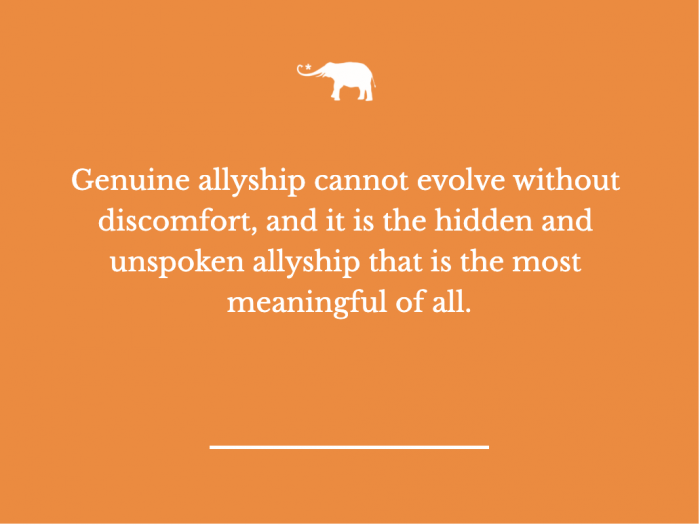~
“During the Second World War, the military built airfields on a number of the South Sea Islands. Streams of aeroplanes flew in with their holds full of useful goodies, flew out again empty, and returned with more cargo. After the war ended, most of these airfields were dismantled completely. The equipment was removed, the personnel left, and the aeroplanes full of useful goodies stopped coming.
The islanders missed their share of the useful goodies. They asked themselves what they needed to do or be for the aeroplanes to come back with their holds full of them. So they repaired what was left of the airfields, or cleaned out long stretches of land to look like them. They lit fires along the airfields, built wooden huts that looked like control towers, and had someone sit in the wooden hut wearing a shaped piece of wood on either side of his head with sticks of bamboo poking out the top like a headset.
It looked to them as if they were doing everything that the military had been doing. Whilst they were doing the visible rituals, they had none of the hidden engines, and none of the underlying worldview and paradigms. They could not know that these hidden engines mattered, not the irrelevant visual rituals.” ~ Excerpt from the book Rebuild: The Economy, Leadership and You by Graham Boyd and Jack Reardon
~
On March 25th, 2020, George Perry Floyd Jr. was killed by Derek Chauvin, the white police officer who had been in the process of arresting him on the suspicion of possessing a counterfeit 20-dollar bill.
Floyd, who was African American, died after Chauvin knelt on his neck for 9 minutes and 29 seconds. The entire incident was captured by a witness on their cellphone camera.
What followed was an explosion of outrage that was unprecedented in its vigour and intensity. Across the globe, protesters gathered in shocked disbelief at the death of yet another Black man at the hands of the police. In Great Britain and across Europe, and in the Caribbean and Latin America, people of all ages and backgrounds cried out against police brutality, and the disproportionate levels of violence perpetrated against unarmed people of colour. Their placards told the story, and messages like End Systemic Racism, I Can’t Breathe, Stop Killing Us, and No Justice, No Peace streamed across mainstream media.
George Floyd joined the unfortunate ranks of his predecessors: Oscar Grant, Daunte Wright, Lt. Caro Nazario, Philando Castile, Sandra Bland, Jordan Davis, Rayshard Brooks, Rev. Clementa C. Pickney, Corey Jones, Elijah McClain, Tamir Rice, Trayvon Martin, Michael Brown, Stephon Clark, Botham Jean, Atatiana Jefferson, John Crawford, Tshyrand Oates, Ahmaud Arbery, Christian Cooper, Eric Garner, and Breonna Taylor. All of the ghosts of the most visceral and documented instances of police profiling and white fragility seemed to be exhumed en masse, and unfurled throughout the collective sensibility of America and the world.
What made the response to George Floyd’s murder different was that, for the first time, there was the noticeable presence of protesters who were not Black. According to the BBC, there was a significant number of white protesters, and protesters from other ethnicities, who stood in solidarity with Black activists. And in the days, weeks, and months to follow, there was also a resounding response from celebrities, athletes, and well-intentioned white voices who summarily condemned the scourge of systemic racism, and pledged to to the necessary work to become allies.
Finally, finally, it seemed as if the fetid presence of racism in America could no longer thrive within the walls of its citadel of impunity, and the cries for justice would be answered. However, even as this newly-formed conscience seems to buoy a sense of salvation and positivity, it is abundantly clear that a great deal of work remains to be done.
Enter the concept of the cargo cult.
From reading the excerpt at the beginning of this article, the term cargo cult can be regarded as the act of going through the motions to build seemingly effective structures without carrying out the accompanying internal work. And this is largely the problem with the vast majority of self-proclaimed white allyship: it is comprised of glorified and grandiose gestures that are meant to fuel a sense of self-congratulatory complacency and smugness, without coming out of the hallowed comfort zone. Genuine allyship cannot evolve without discomfort, and it is the hidden and unspoken allyship that is the most meaningful of all.
It is precisely these grandiose and meaningless gestures that help to buttress that citadel of racism rather than tear it down. Because we all get swept up and distracted in the promises held and the hopes that are formed, and stop reaching toward that discomfort that will actually facilitate the change that is needed. We are living in the shadow of this cargo cult, and the darkness will continue to take hold if we do not do all that we can to stop it.
Over the past few months, this darkness has been roiling through our world, and it is time to sit up and take notice. It has been signaled by many things, an example of which is the series of grisly discoveries of thousands of unmarked graves containing the bodies of indigenous children on the sites of residential schools across Canada. Despite the testimony of the many thousands of survivors of these schools that were meticulously documented by the Canadian Truth and Reconciliation Commission between 2008 and 2015, somehow there was still shock expressed at that discovery of these graves. Somehow, there was still shock, despite the fact that these thousands of survivors describe in brutal, vivid detail having to dig the graves of their classmates. Yet, the cargo cult of the Canadian Truth and Reconciliation Commission helped us to turn away from the inevitable, tragic logic that, according to Scientific American, in light of the fact that more than 1,300 graves have been identified using ground-penetrating radar at only four of the 139 federally run residential schools, the official number of 4,120 students who are known to have died in the schools will end up being only a fraction of the actual total.
It remains to be seen whether the appointment of Mary Simon, Canada’s first Governor General of indigenous heritage, will serve to dismantle or amplify the legacy of the cargo cult.
Other examples of cargo cult thinking can lie much closer to home, as seen in the experience of one of the founders of Omnis Education, Lea Jovy-Ford. Lea’s children used to attend a highly esteemed school, and Lea was confident in this choice of school for her children because, among other things, its leader had taken part in an anti-racism workshop, was a self-proclaimed ally, and seemed ready and willing to do the necessary work. However, when Lea’s children were repeatedly subjected to racist remarks and insults, the leader of the school chose instead to ignore the magnitude of the problem. As Lea observed in a Facebook post, “I was so hopeful that [the school] would be a beacon of learning, growth and anti-discriminatory practice protecting ALL children, unfortunately this has not been the case and white fragility and performative actions in relation to anti racism have governed policy and practice instead.”
Indeed, “performative actions” lie at the heart of a cargo cult mentality, and as mentioned in the excerpt above, without the accompanying paradigm shift, and the building of the “hidden engines,” this type of “allyship” causes more harm than good.
So, where does this leave us? What is a way forward? That is a question that will remain unanswered, until we acknowledge and accept the extent to which we are all capable of cargo cult thinking, and properly confront the implicit biases that we all possess. This cannot be done without being uncomfortable.
In short: if it doesn’t seem like work, it’s not actually working.
Without a genuine immersion in the work of dismantling systemic and personal racism, the reality of every person of colour will always be summed up by the thoughts of David Gray in his piece Preparing for Daycare:
“I need to drive my two-year-old to daycare tomorrow morning. To ensure we arrive alive, we won’t take public transit (Oscar Grant). I removed all air fresheners from the vehicle and double-checked my registration status (Daunte Wright), and ensured my license plates were visible (Lt. Caron Nazario). I will be careful to follow all traffic rules (Philando Castille), signal every turn (Sandra Bland), keep the radio volume low (Jordan Davis), and won’t stop at a fast food chain for a meal (Rayshard Brooks). I’m too afraid to pray (Rev. Clementa C. Pickney) so I just hope the car won’t break down (Corey Jones).
When my wife picks him up at the end of the day, I’ll remind her not to dance (Elijah McClain), stop to play in a park (Tamir Rice), patronise the local convenience store for snacks (Trayvon Martin), or walk around the neighbourhood (Mike Brown). Once they are home, we won’t stand in our backyard (Stephon Clark), eat ice cream on the couch (Botham Jean), or play any video games (Atatiana Jefferson).
After my wife and I tuck him into bed around 7:30pm, neither of us will leave the house to go to Walmart (John Crawford) or to the gym (Tshyrand Oates) or on a jog (Ahmaud Arbery). We won’t even walk to see the birds (Christian Cooper). We’ll just sit and try not to breathe (George Floyd) and not to sleep (Breonna Taylor).”


 Share on bsky
Share on bsky





Read 2 comments and reply